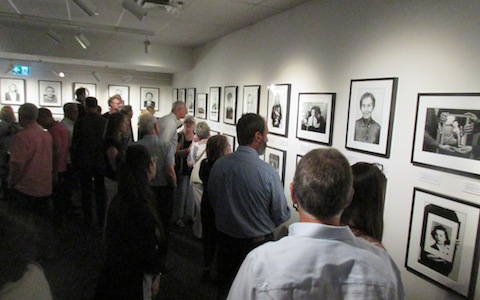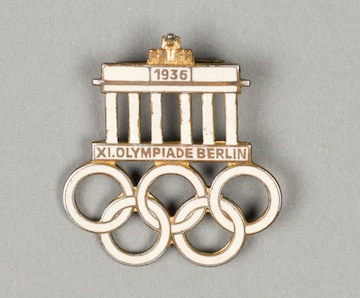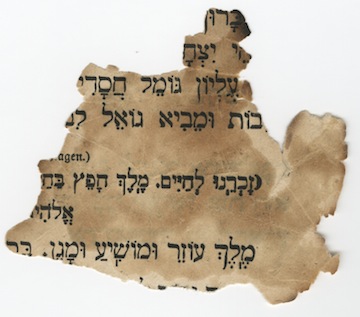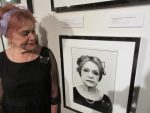Jannushka Jakoubovitch, a Holocaust survivor, looks at her portrait, taken by Pulitzer Prize-winning photographer Marissa Roth, part of the Faces of Survival exhibit at the VHEC. (photo by Pat Johnson)
Two new original exhibits opened at the Vancouver Holocaust Education Centre recently, concurrent with the opening of the centre’s redeveloped space.
Following the annual general meeting of the Vancouver Holocaust Centre Society for Education and Remembrance on June 20, attendees moved from the Jewish Community Centre of Greater Vancouver’s Rothstein Theatre to the Holocaust centre for the official opening of the exhibits and a first look at the revamped space. (An article on the centre’s renewal project will appear in a future issue.)

Both exhibits emphasize local relevance of broader Holocaust history.
In Focus: The Holocaust through the VHEC Collection includes items that the Holocaust centre has assembled over decades. Thematic aspects of Shoah history are illustrated through documents, photographs and artifacts. Interactivity is incorporated through replica items in adjacent drawers, which visitors can handle and explore. Electronic kiosks encourage deeper and broader exploration of topics, including cross-referenced databases that connect, for example, all holdings related to an individual, a place, an event or other search query.
Among the items on display are a yellow Star of David worn in the Theresienstadt camp in Czechoslovakia, a fragment of a prayer book burned during Kristallnacht in 1938 and found on the street in Berlin after the violence temporarily subsided, and a photo album of life in the Netherlands under Nazi occupation, created from negatives that were developed in 1981 and donated to the VHEC.

Also on display is a Torah scroll from Prague, which, along with 100,000 other Czechoslovakian Jewish religious objects, was gathered by the Central Jewish Museum in Prague at the behest of Nazi officials.
A souvenir pin from the 1936 Olympic Games in Berlin, featuring a replica of the Brandenburg Gate, and a porcelain figurine of an idealized Aryan woman produced around the same time speak to that portentous international sporting event.
Artifacts from life in hiding include a wooden toy dog that belonged to local child survivor Robert Krell. Among the most unusual items on display is a chess set modeled from chewed bread and sawdust, then painted and varnished.
“These finely articulated pieces are believed to be the work of a Polish Jewish man interned in the Warsaw Ghetto,” according to the exhibit descriptor. “He likely offered the set to a soldier stationed as a guard in the ghetto, in exchange for food.”
Photographs illustrate life in the ghettos, life in hiding and the “Holocaust by bullets,” the process of mass murder in Eastern Europe perpetrated by Einstatzgruppen (Nazi death squads) and collaborators.
Also on display is a recipe book compiled by Rebecca Teitelbaum, the aunt of Vancouver-area Holocaust survivor Alex Buckman. While working in a Siemens ammunition factory in the women’s concentration camp Ravensbrück, the exhibit explains, “At great risk of being discovered and killed, she stole pencils and paper to record her recipes and those of other inmates.”
A child’s shoe recovered from the Kanada barracks at Auschwitz II-Birkenau is on exhibit. “This shoe, belonging to a child of age 3 or 4, was retrieved after the Second World War. Young children deported to Auschwitz were among the first to be selected for the gas chambers. An estimated one million Jewish children were murdered by the Nazis and their collaborators during the Holocaust – 220,000 children died in Auschwitz alone.”

Also on display is a letter, dated April 20, 1945, from U.S. soldier Tom Perry to his wife Claire after arriving in the liberated Buchenwald concentration camp.
“I want to write you tonight about one of the most moving experiences I’ve ever had, as well of as one of the most horrible things I have ever seen.… With the idea not of pleasing you, for what I saw there was really too horrible to be seen by any decent human being. But with the thought that as my wife you would want to share with me my most horrible as well as my pleasant experiences. And because I think the rest of the family and our friends should know from personal observations what bestial things the Nazis have done, and what a dreadful menace they have been to people all over the world.” The letter proceeds in graphic detail.
The second exhibit is even more intimately connected with the local community. Faces of Survival: Photographs by Marissa Roth consists of portraits of British Columbians who survived the Shoah. Roth, a Pulitzer Prize-winning photographer who created a similar exhibit at the Museum of Tolerance / Simon Wiesenthal Centre in Los Angeles, took portraits of survivor volunteers, including both past and present VHEC outreach speakers and board members. In cases where the survivors themselves have passed away, the portraits feature family members holding a photo of the survivor.
The subjects were asked two questions: “Why do you think it is important to remember the Holocaust?” and “What message do you want to convey to students?” From their answers, captions were created to accompany the portraits in the exhibition, which was made possible by the Diamond Foundation.
Accompanying Agi Bergida’s portrait are the words: “My great hope is in the young people, the new generation. Racism is ignorance, to which the answer is education.”
Marion Cassirer, who died in Vancouver in 2014, is pictured in a photograph held by her daughter, Naomi Cassirer. “The Holocaust happened a long time ago, but for our family and for many others, it never ended,” said her daughter. “Marion spent the rest of her life speaking to groups about her family’s experiences, hoping that people would learn and understand that no society is immune.”
Serge Haber said, “It is important to remember the Holocaust because it can happen again, and it can happen here.”
A photograph of the late Paul Heller, held by his daughter Irene Bettinger, is accompanied by her words: “Dangerous human behaviour continues to this day, including antisemitism. Every one of us must participate in efforts to combat such behaviour if our freedoms and democracies are to survive.”
Accompanying Evelyn Kahn’s portrait are her words: “In a world where the media reports events absent of historical truth, the most essential tool becomes survivor testimony.”
The photograph of Peter Parker, who survived Birkenau and Dachau as well as a death march and died in Vancouver in 2015, includes words from his 1987 testimony: “Every human being has good and bad in them, we are capable of the highest noble things and the lowest deeds.”
Claude Romney, who survived in hiding, said: “We, as the last witnesses, have a duty to warn the world of the dangers of targeting any ethnic or religious group; for discrimination and persecution can lead to extermination, as it did under the Nazis.”
The late Bronia Sonnenschein was a survivor of the Lodz Ghetto, Birkenau and Stuthoff concentration camps and a death march from Dresden to Theresienstadt. Dan Sonnenschein, her son, said, “In her many years of Holocaust education, my mother honoured not only the memory of the murder victims and the other victims who survived, but understood the virulent intensity of antisemitism as ‘the longest hatred’ and the need to combat its current forms.”
Louise Stein Sorensen, a survivor of the Amsterdam Ghetto who survived in hiding, said: “The Holocaust teaches us to arm ourselves against the abuse of human rights.”
Both exhibits continue until next year, and information on opening hours and other details can be found at vhec.org.
After the routine business of the annual general meeting, Dr. Ilona Shulman Spaar, VHEC education director, presented the 2018 Meyer and Gita Kron and Ruth Kron Sigal Award to educators Sharon Doyle of South Delta Secondary and Julie Mason of David Oppenheimer Elementary in Vancouver. The award recognizes excellence in Holocaust education and genocide awareness in B.C. elementary and high schools.
Ed Lewin, past president of the organization, conferred life fellowships on Ethel Kofsky and Dr. Martha Salcudean.
Introductions and explanations of the new exhibitions, as well as of the renovated centre, were presented by Nina Krieger, VHEC executive director, architect Brian Wakelin, principal of Public: Architecture + Communication, and Shulman Spaar. Hodie Kahn offered reflections from a second-generation perspective.

